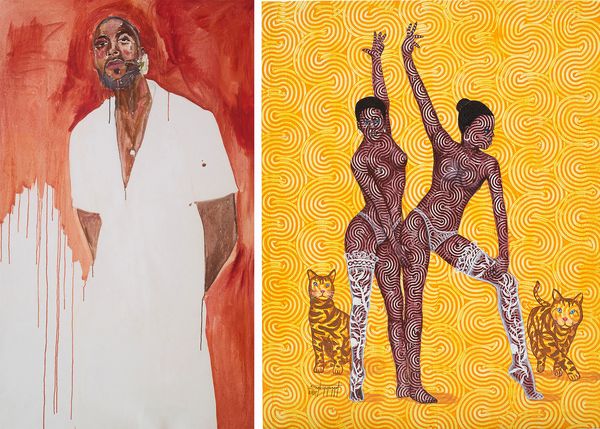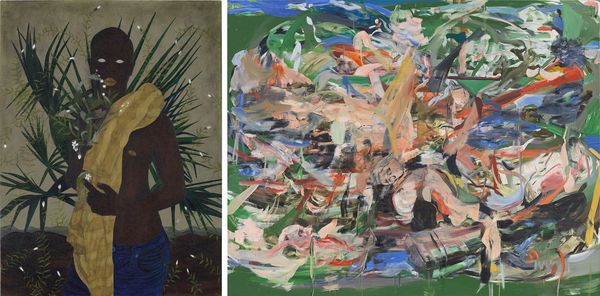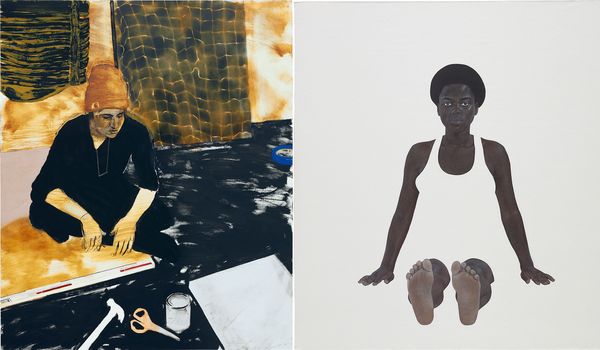Left: Doron Langberg, Amy in Her Studio, 2017. 20th Centuy & Contemporary Art Evening Sale. Right: Sungi Mlengeya, Chaotic Disposition, 2020. 20th Century & Contemporary Art Day Sale.
For some, the doldrum days between February and March are yet another opportunity to take stock of the changes behind and the days ahead. In that spirit, we've looked to the emerging artists of our 20th Century & Contemporary Art Day & Evening London Sales for six timeless lessons in personal growth that will (hopefully) bring out the best in us.
Vulnerability: Doron Langberg & Sungi Mlengeya
It’s rather fitting that February is split exactly (most of the time) in half by the lead up to and the fallout from a commercial holiday about love, and one that explicitly targets our vulnerability toward the world. As Doron Langberg and Sungi Miengeya capture so acutely, it’s the vulnerability of self that endures and endears.
Israeli-born, New York-based Doron Langberg creates vibrant works typified by vulnerability, queer intimacy, and community. Shown here alone, Langberg’s friend and fellow artist Amy sits pensively in her studio, elusive and absorbed in thought, the tools of her trade scattered around her. As a working space where the artist explores ideas and turns them into material realities, the studio vividly captures this porous exchange between interiority and environment. Self-taught Tanzanian artist Sungi Miengeya’s exploration of negative space in Chaotic Disposition (2020) presents an intimate, liberating moment alone; the kind of moments that allow us to find whatever is it we want – clarity, silence, anything – away from external pressures.

Left: Serge Attukwei Clottey, Jidenna, 2020-2021. 20th Century & Contemporary Art Day Sale. Right: Foster Sakyiamah, Yellow Girls Synced, 2021. 20th Century & Contemporary Art Day Sale.
Poise: Serge Attukwei Clottey & Foster Sakyiamah
Powerfully self-possessed, Ghanaian artist Serge Attukwei’s figures embody a poise and elegance we might all aspire to. This is especially evident in Jidenna (2020–2021), where the subject’s face is turned slightly upward, equally inquisitive and knowing. Clottey is perhaps best known for his Afrogallonism concept, making use of the ubiquitous yellow gallon containers around Accra to invent works in myriad forms. However, Clottey’s focus on the figure carries equal weight in his practice, here offering a compelling counterpoint to his assemblages.
So too does Foster Sakyiamah’s Yellow Girls Synced (2021) exhibit this graceful balance – neither practiced stoicism or performative gesture, but an inalienable confidence that shines through any pose. Another emerging Ghanian talent, Sakyiamah is a graduate of Ghanatta College of Art and Design whose paintings express the dynamic richness of subjects interacting with their environment in expressive, composed ways. Grecian-style swirls and feline accompaniment create an energy in the present work as it builds around the canvas, poised to launch into kinetic movement at the subjects’ count

Left: Rafa Macarrón, Balcones, 2018. 20th Century & Contemporary Art Evening Sale. Right: Avery Singer, Prada Mask, 2012. 20th Century & Contemporary Art Day Sale.
Dimension: Rafa Macarrón & Avery Singer
Leave it to flatness to give a perfect summary of dimension. Self-taught artist Rafa Macarrón’s subjects in Balcones (2018) engage with their surroundings in a way that pushes the limits of two-dimensional space. His 13 subjects smoke cigarettes, sit under rain clouds, and look out from comically sized glasses, stacked against an acid yellow and fluorescent orange ground. A physiotherapist by training, Macarrón has a carefully studied knowledge of human anatomy, which he relates directly to his characteristic distorted figures and simplified gestures, pushed right up against the picture surface.
The deceptive simplicity of Avery Singer’s Prada Mask (2012) – centered by its voided eyes – offers a look at the infinite depth of a single color. Singer’s use of technology is key in her practice: the artist manipulates technologies to illustrate historical artistic references and explore the possibilities of software. The present work uses an architectural design modeling program to render a flattened, sharp refocus of the artist’s engagement with Modernism.

Left: Jadé Fadojutimi, Swamp, 2015. 20th Century & Contemporary Art Day Sale. Right: Jordy Kerwick, Cool Cats, 2019. 20th Century & Contemporary Art Day Sale.
Resilience: Jadé Fadojutimi & Jordy Kerwick
Resilience is a twofold implication: first, the ability to bounce back from difficulty; second, the ability to shape a path forward. Jadé Fadojutimi’s Swamp (2015) is an example of the artist’s exploration into the abstract places of her mind. Born and raised in East London to Nigerian parents, Fadojutimi’s British-Nigerian cultural duality raised continuous questions for the artist around identity. A transitional environment combining both land and water and operating as a site of rebirth and transformation even in the face of unwelcoming conditions, it is tempting to read an autobiographical element at work in this stunningly light composition.
Resilience is also a staple in parables and folklore, two influences for Australian artist Jordy Kerwick. The self-taught painter explores the imagination as a landscape of its own, one to be fully embraced instead of limited by expectation. Kerwick’s tactile surfaces are rendered in thick layers of oil paint. The present work, Cool Cats (2015), is an exercise in repetition; the artist created several iterations of flowers and bookstacks, often with cheeky references – not in search of perfection, but rather as examples of the repetitive nature of everyday life and the simple difference between falling into routine and finding enjoyment.

Left: Lauren Quin, Airsickness, 2021. 20th Century & Contemporary Art Evening Sale. Right: Antonia Showering, It Wasn't To Be, 2017. 20th Century & Contemporary Art Day Sale.
Vitality: Lauren Quin & Antonia Showering
Ah, vitality, the quality that beacons outward and brings others to us. It is magnetic, hard to place, but immediately felt. California-based artist Lauren Quin’s Airsickness (2021) seems at a digital collage; however, her methods are remarkably analog, involving drawing, scratching, systematic mark-making, and a form of trace mono-printing whereby the surface of the work is gently pressed onto an ink-covered pane of glass. These stained and carved line drawings create an organic warmth that draws the viewer in all directions, following the energy of snaking tubes that oscillate between microscopic and interdimensional.
Opposite Quin’s immutable vitality, Antonia Showering transforms the familiar glow of a family portrait into a self-contained universe. Almost Polaroid-like in its framing – not fully focused, off-center, with indeterminate subjects – the British artist gives us a glimpse of a shared moment, as if taking a picture, not as a fellow family member, but as a passerby asked kindly to hold the camera. There, in the viewfinder, we find what we are most drawn to: an invitation to see and be seen, a reciprocal form of interaction between art and life.

Left: Cinga Samson, Ubuhle beenkanyezi VIII, 2018. 20th Century & Contemporary Art Evening Sale. Right: Cecily Brown, When Time Ran Out, 2016. 20th Century & Contemporary Art Evening Sale.
Connection: Cinga Samson & Cecily Brown
So crucial is connection to life that after the fuss of food, water, and shelter, connection can be understood as the formative element of the human condition. The methods with which we create connections go beyond the constraints of the knowable world, and so are constantly forming novel ways of expression. Cinga Samson's Ubuhle beenkanyezi VIII (2018) translates from the Zulu dialect as The Beauty of the Stars – its subject appears as a messanger between two realms, liminally between physical and spiritual planes. With its otherworldly eyes and possessive stance, the subject comes into frame with a conceptual distance, although its presence signals an imperative: connection. Whether present to warn, empower, or relay, the messenger as a universal subject is the connective tissue between the viewer and world it inhabits.
A connection with history is at the heart of Cecily Brown's When Time Ran Out (2016). The shipwreck – one of Brown's signature motifs – draws its intensity directly from Jean-Louis Théodore Géricault’s 19th century masterwork, La Balsa de la Medusa, as its contorted figures strain against their fates. Some faces are trodden, others defiant in a critical moment in Géricault’s version, as a rescue ship is finally spotted in the distance. Brown’s abstracted painting replaces the horizon with the gangrenous hue of decay, and yet, in the composite chaos, we see her faces seeking each other, looking outward, attempting to find something, even in a hopeless situation. The imperative here is Beckettian: “I can’t go on. I’ll go on.”
Discover More from 20th Century & Contemporary Art >
Recommended Reading
